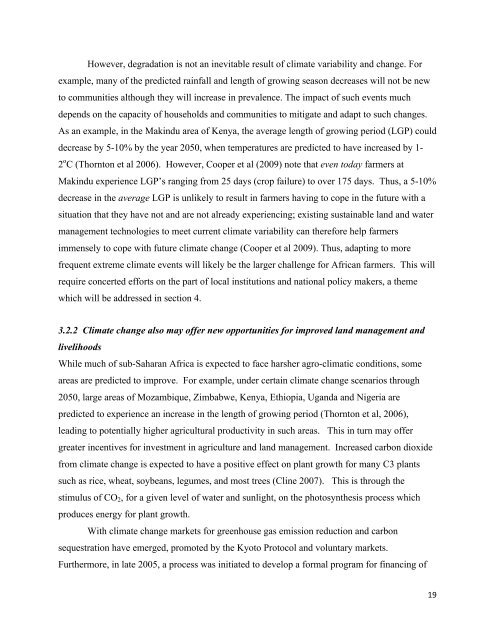The Role of Sustainable Land Management for Climate ... - CAADP
The Role of Sustainable Land Management for Climate ... - CAADP
The Role of Sustainable Land Management for Climate ... - CAADP
Create successful ePaper yourself
Turn your PDF publications into a flip-book with our unique Google optimized e-Paper software.
!<br />
However, degradation is not an inevitable result <strong>of</strong> climate variability and change. For<br />
example, many <strong>of</strong> the predicted rainfall and length <strong>of</strong> growing season decreases will not be new<br />
to communities although they will increase in prevalence. <strong>The</strong> impact <strong>of</strong> such events much<br />
depends on the capacity <strong>of</strong> households and communities to mitigate and adapt to such changes.<br />
As an example, in the Makindu area <strong>of</strong> Kenya, the average length <strong>of</strong> growing period (LGP) could<br />
decrease by 5-10% by the year 2050, when temperatures are predicted to have increased by 1-<br />
2 o C (Thornton et al 2006). However, Cooper et al (2009) note that even today farmers at<br />
Makindu experience LGP’s ranging from 25 days (crop failure) to over 175 days. Thus, a 5-10%<br />
decrease in the average LGP is unlikely to result in farmers having to cope in the future with a<br />
situation that they have not and are not already experiencing; existing sustainable land and water<br />
management technologies to meet current climate variability can there<strong>for</strong>e help farmers<br />
immensely to cope with future climate change (Cooper et al 2009). Thus, adapting to more<br />
frequent extreme climate events will likely be the larger challenge <strong>for</strong> African farmers. This will<br />
require concerted ef<strong>for</strong>ts on the part <strong>of</strong> local institutions and national policy makers, a theme<br />
which will be addressed in section 4.<br />
3.2.2 <strong>Climate</strong> change also may <strong>of</strong>fer new opportunities <strong>for</strong> improved land management and<br />
livelihoods<br />
While much <strong>of</strong> sub-Saharan Africa is expected to face harsher agro-climatic conditions, some<br />
areas are predicted to improve. For example, under certain climate change scenarios through<br />
2050, large areas <strong>of</strong> Mozambique, Zimbabwe, Kenya, Ethiopia, Uganda and Nigeria are<br />
predicted to experience an increase in the length <strong>of</strong> growing period (Thornton et al, 2006),<br />
leading to potentially higher agricultural productivity in such areas. This in turn may <strong>of</strong>fer<br />
greater incentives <strong>for</strong> investment in agriculture and land management. Increased carbon dioxide<br />
from climate change is expected to have a positive effect on plant growth <strong>for</strong> many C3 plants<br />
such as rice, wheat, soybeans, legumes, and most trees (Cline 2007). This is through the<br />
stimulus <strong>of</strong> CO 2 , <strong>for</strong> a given level <strong>of</strong> water and sunlight, on the photosynthesis process which<br />
produces energy <strong>for</strong> plant growth.<br />
With climate change markets <strong>for</strong> greenhouse gas emission reduction and carbon<br />
sequestration have emerged, promoted by the Kyoto Protocol and voluntary markets.<br />
Furthermore, in late 2005, a process was initiated to develop a <strong>for</strong>mal program <strong>for</strong> financing <strong>of</strong><br />
!<br />
$,!

















